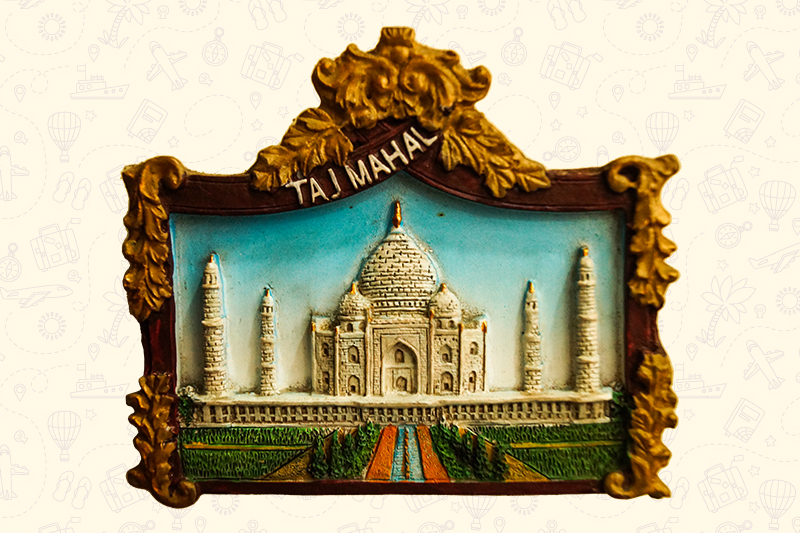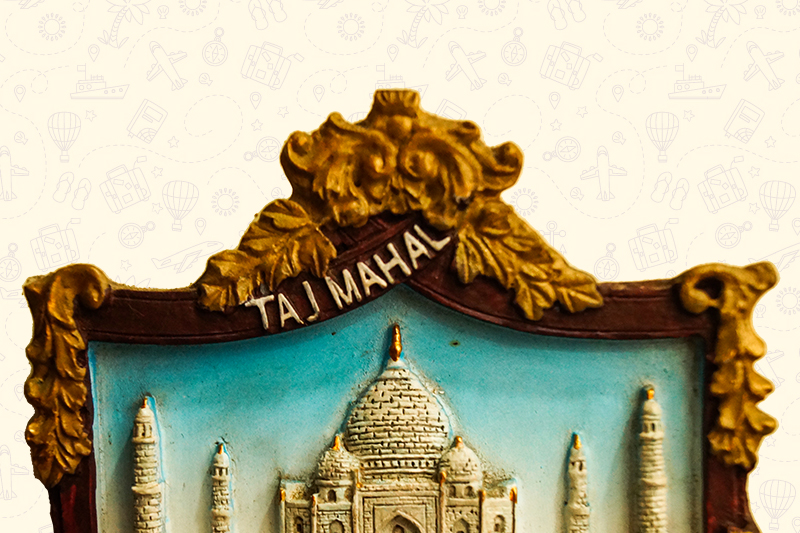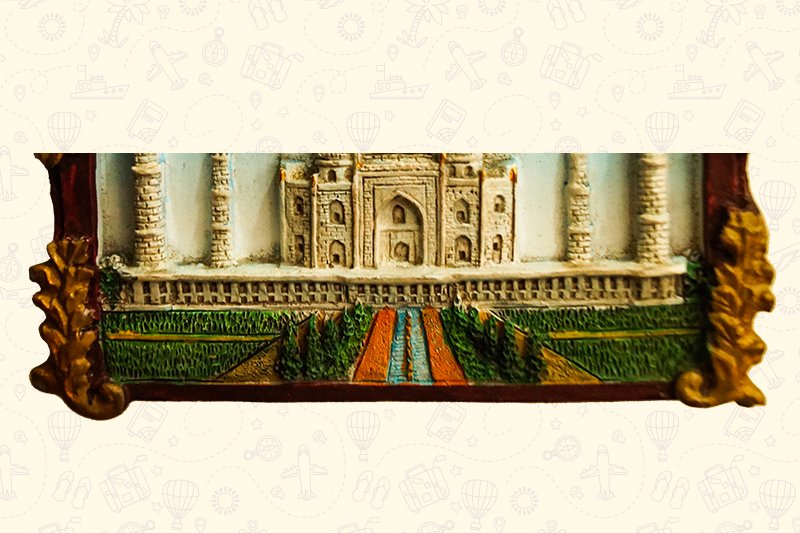The Taj Mahal is an iconic symbol of love and one of the most famous architectural wonders globally. Situated in Agra, India, this UNESCO World Heritage site was constructed by the Mughal Emperor Shah Jahan in the memory of his beloved wife, Mumtaz Mahal.
Work on the Taj Mahal began in 1632 and spanned around two decades, employing a vast number of skilled artisans, architects, and labourers. It stands as a prime example of Mughal architecture, seamlessly blending Persian, Islamic, and Indian styles. Crafted from white marble, the Taj Mahal showcases meticulous detailing and intricate designs. Its main structure is embellished with delicate carvings, calligraphy, and inlays of precious gemstones. The grand dome, along with four smaller domes, crowns the mausoleum, while a reflecting pool enhances its enchanting allure.
Beyond its architectural splendour, the Taj Mahal embodies a profound love story. Emperor Shah Jahan’s profound affection for his wife is immortalised in its design and craftsmanship, reflecting a deep emotional connection. Visitors from across the globe flock to the Taj Mahal to marvel at its beauty and soak in its serene ambiance. The monument exhibits an ever-changing aura, transitioning from a soft pink hue at sunrise to a gleaming white during the day, and a golden radiance at sunset.
Inside, the Taj Mahal houses the tombs of Shah Jahan and Mumtaz Mahal. The interior showcases exquisite marble lattice screens, intricate inlays, and Quranic verses adorning the walls. As a significant cultural and historical site, the Taj Mahal attracts millions of tourists annually, serving as a testament to architectural brilliance and eternal love. Its harmonious fusion of design elements, timeless beauty, and emotional resonance continue to captivate people worldwide.
Conservation Efforts
Conservation efforts for the Taj Mahal have been ongoing to preserve its beauty and protect it from the effects of time, pollution, and environmental factors. Several measures have been implemented to ensure the long-term sustainability of this iconic monument. One of the significant challenges faced by the Taj Mahal is air pollution. To address this issue, strict regulations have been enforced to control industrial emissions, vehicular pollution, and the burning of fossil fuels in the surrounding areas. Efforts have also been made to relocate polluting industries away from the vicinity of the Taj Mahal.
Regular cleaning and maintenance activities are carried out to prevent the accumulation of dirt, grime, and pollutants on the monument’s surface. Specialised cleaning techniques and gentle detergents are used to avoid any damage to the delicate marble. The groundwater level around the Taj Mahal is monitored closely to prevent any adverse effects on its foundation. Conservationists have implemented measures such as water harvesting, installation of drains, and proper drainage systems to control waterlogging and prevent any potential damage.
Vegetation and trees surrounding the Taj Mahal are carefully maintained to create a buffer zone and minimise the impact of dust and pollutants. Afforestation drives have been conducted in nearby areas to improve the overall air quality and create a healthier environment for the monument.
Conservation experts regularly conduct research and studies to better understand the unique challenges faced by the Taj Mahal and develop innovative preservation methods. Advanced technologies, such as laser scanning and 3D modelling, are used for documentation and monitoring of the monument’s condition.
Additionally, visitor management and control measures have been implemented to regulate the number of tourists visiting the Taj Mahal and ensure its sustainability for future generations. Strict guidelines are in place to prevent any damage or vandalism to the monument.
Conservation efforts for the Taj Mahal are a collaborative endeavour involving government bodies, conservation organizations, researchers, and local communities. The aim is to safeguard this architectural marvel for posterity and maintain its cultural and historical significance as a treasure of India’s heritage.
The Magnet from Taj Magnet

The magnet from Taj Mahal represents the marble monument in a stunning way. The magnet showcases not only the monument but also the beauty of its surrounding areas.

Right at the centre of the magnet is the Taj Mahal. Even though the magnet is a miniature, it manages to capture the architectural details as well as the intricate carvings that the Taj Mahal is known for.

The magnet is framed in a golden and brown frame that is representative of the Indian décor as well as the intricate carvings that the monument is popular for.

At the base of the monument, the river, lined with trees and lush gardens are depicted. The area surrounding the Taj Mahal is maintained the same way.
Exploring Agra
Agra, the city of the Taj Mahal, offers a wealth of attractions and experiences for visitors. Here are some things to do in Agra:
- Explore Agra Fort: Discover the historical Agra Fort, a UNESCO World Heritage site. Explore its grand palaces, courtyards, and mosques while enjoying panoramic views of the Taj Mahal from certain vantage points within the fort.
- Explore Fatehpur Sikri: Take a day trip to Fatehpur Sikri, a magnificent deserted city located near Agra. Explore the well-preserved palaces, mosques, and other architectural marvels that showcase the grandeur of the Mughal Empire.
- Discover Itmad-ud-Daulah’s Tomb: Also known as the “Baby Taj,” this exquisite marble tomb is a precursor to the Taj Mahal. Admire its intricate inlay work and serene ambiance.
- Take a Heritage Walk: Embark on a heritage walk through the streets of Agra’s old city, where you can explore bustling markets, taste local street food, and witness the vibrant culture of the city.
- Enjoy Mughlai Cuisine: Indulge in the delectable flavours of Mughlai cuisine, known for its rich and aromatic dishes. Don’t miss trying Agra’s famous specialty, the petha, a sweet made from ash gourd.
- Explore Mehtab Bagh: Visit Mehtab Bagh, a garden located across the Yamuna River from the Taj Mahal. Enjoy a serene view of the Taj Mahal from this tranquil spot, especially during sunset.
- Attend a Mohabbat the Taj Show: Experience the grandeur of the Taj Mahal through a live cultural show called “Mohabbat the Taj.” This theatrical production showcases the story behind the Taj Mahal’s creation through music, dance, and drama.
- Visit Akbar’s Tomb: Pay a visit to the tomb of Emperor Akbar in Sikandra, a beautiful mausoleum surrounded by lush gardens. Admire the intricate architectural details and peaceful ambiance of this historical site.
- Explore the Local Markets: Take a stroll through the local markets of Agra, such as Sadar Bazaar and Kinari Bazaar, where you can shop for handicrafts, marble artifacts, textiles, jewellery, and more.
- Visit the Jama Masjid: Explore the Jama Masjid, one of the largest mosques in India. Admire its beautiful architecture and serene atmosphere.
- Take a Tonga Ride: Experience a traditional horse-drawn carriage ride, known as a Tonga, through the streets of Agra. It’s a charming and nostalgic way to explore the city.
- Visit the Mughal Heritage Walk: Join a guided heritage walk that takes you through the lesser-known parts of Agra, showcasing the city’s hidden gems and local way of life.
- Visit the Guru Ka Taal: Explore the historic Sikh shrine, Guru Ka Taal, which features a beautiful mausoleum and a serene water tank. It holds religious significance for the Sikh community.
- Attend a Cultural Dance Performance: Enjoy a captivating cultural dance performance showcasing traditional dance forms like Kathak and Bharatanatyam, accompanied by live music.
- Take a Boat Ride on the Yamuna River: Experience a peaceful boat ride on the Yamuna River, offering a unique perspective of the Taj Mahal and Agra’s skyline.
- Visit the Wildlife SOS Elephant Conservation Centre: Take a trip to the nearby Wildlife SOS Elephant Conservation Centre, where you can learn about and interact with rescued elephants.
- Explore the Agra Marble Emporium: Visit a marble emporium to witness the intricate craftsmanship of Agra’s marble artisans and shop for exquisite marble souvenirs.
- Attend the Taj Literature Festival: If your visit coincides with the Taj Literature Festival, immerse yourself in literary discussions, book readings, and cultural performances.
